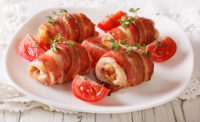Refrigerated bacon sales reached $4.4 billion, growing 3.5 percent in U.S. retailers for the year ending July 9, according to IRI, a Chicago-based market research firm. Bacon’s growth is not surprising as the product found a second life in the trend cycle a few years ago, when chefs and manufacturers began adding it to everything from donuts to vodka.
Bacon is all over menus, with chefs experimenting with new preparations, flavors and cuts. This trend has really continued to this day with bacon experiencing growth across all menu parts during the past year, including notable growth among desserts and beverages which are both up 17 percent, according to Datassential, Chicago.
TOP 10 REFRIGERATED BACON BRANDS

Source: Infoscan Reviews, IRI - the leading global provider of enterprise market information solutions
Latest 52 Weeks Ending July 9, 2017. Total U.S. Multi-Outlet (Supermarkets, Drugstores, Mass Market Retailers, Military Commissaries and Select Club & Dollar Retail Chains)
Editor’s Note: Rankings of top brands are NOT totaled brand listings (e.g. all UPCs or brand extensions rolled up into a single figure, such as Total Crest Toothpaste), but are
rather individual brand listings. Please cite accordingly.
“Bacon consumption levels are at historical highs driven by the proliferation of bacon usage across meal occasions and meal recipes both in the home and in restaurants,” says Jeremy Truxal, brand manager at Oscar Mayer, in Chicago. “… The increase in bacon consumption is expected to continue into the foreseeable future.”
At the same time, Datassential reports that increased interest in barbecue and pork centric global dishes has brought strong growth for a number of pork varieties and dishes during the last four years, including bold, premium bacon varieties such as apple wood smoked bacon, thick-cut bacon and candied bacon. This increased interest in pork has even spawned entire restaurant concepts devoted to pork and/or bacon. One such concept is Bar Bacon in New York City, where diners can get an Artisanal Bacon Tasting Plate for an appetizer, a Kentucky Fried Bacon Burger for their entrée and Chocolate Covered Bacon for dessert.
“Consumers are finding more and more ways to use bacon,” says Nick Schweitzer, senior brand manager for Hormel Foods, in Austin, Minn. “It truly is the meat that makes everything better.” The industry also continues to see bacon consumed outside of breakfast, lunch and dinner from bacon stir sticks in Bloody Mary cocktails to crumbled bacon as a topping on doughnuts or ice cream, he adds.
Bacon’s growth is definitely not limited to bacon slices. “You are seeing bacon bits as well being used throughout the day in menu development,” says Michael Richardson, chief operations officer at SugarCreek, Cincinnati.
Datassential reports bacon is still heavily favored as a breakfast protein and has maintained its strong penetration in recent years. Growth is still occurring in the breakfast daypart, though, with specific flavored bacons and varieties on the rise. Nevertheless, bacon’s strongest growth in recent years has occurred on dinner menus, Datassential reports. Bacon penetration has increased at dinner by 6 percent during the past year and 8 percent compared with four years ago, while bacon lunch menu penetration is up 6 percent during the past four years, the research firm reports.
In turn, bacon is consistently one of the top menued proteins across multiple day parts and across a diverse range of item types. Bacon is featured at 70 percent of restaurants overall, with only chicken, beef and eggs appearing on menus more frequently, Datassential reports. Menu penetration for bacon has increased every year since 2011, with penetration up during one-year (up 1 percent), four-year (up 4 percent) and 10-year (up 6 percent) time trends, the research firm says.
Bacon is finding growth in a number of ways in restaurants, too. Notable areas of growth include: flavored and interesting preparations, such as candied bacon (up 218 percent); brown sugar bacon (up 113 percent); maple bacon (up 84 percent); jalapeño bacon (up 44 percent); several smoked bacon varieties (applewood, hickory and cherrywood) and house-cured bacon (up 23 percent). Authentic ethnic variations such as guanciale (up 58 percent), lardon (up 44 percent), speck (up 18 percent) and pancetta (up 11percent) also are sporting growth. Restaurants also are using unique proteins to bolster growth. The most common is turkey bacon (up 20 percent), but other protein types such as beef, duck and lamb bacons are finding growth as well.
Bacon also is growing across all menu parts, Datassential reports. The strongest growth is occurring outside the entrée menu is among beverages (up 231 percent), desserts (up 80 percent) and appetizers (up 16 percent). These less traditional menu parts for bacon also tend to display the strongest innovation with bacon turning up in more unique applications such as shakes, sundaes, bacon tasting flights and cocktails, the research firm reports. Additionally, bacon is finding growth as a sauce and/or flavor. Examples include bacon jam, bacon butter, bacon marmalade and bacon mayo. These are most commonly used as a topper for burgers and sandwiches, Datassential says.
Price and demands
With restaurants’ demand for bacon products and bacon’s use at home, bacon production has been exceptionally strong, and U.S. consumers’ attraction to bacon has grown significantly during the past five years.
“Structurally, the demand curve for bacon has shifted higher,” says Michael Merritt, Smithfield, Va.-based Smithfield Foods’ senior director of brand marketing. “Phenomenal demand at both the foodservice and retail sectors coupled with the tightest U.S. pork belly freezer stocks have sent pork belly prices soaring this summer. As fall approaches, harvest levels are expected to increase. Increased belly availability and some demand erosion due to higher pricing during the summer are expected to lead to a price correction into fall.”
In the latest 52 weeks ending July 22, dollar sales increased 2.1 percent to $4.6 billion, volume sales increased 0.9 percent to 939.9 million units and the average unit price grew 1.2 percent to $4.88, according to Chicago-based Nielsen’s total U.S. tracking of UPC-coded bacon for all outlets combined.
“Bacon continues to see moderate growth in volume as prices have risen over the last year,” says Meagan Nelson, associate director of Fresh Growth and Strategy at Nielsen.
With record pork belly demand this year and strong export demand, SugarCreek’s Richardson says bacon demand is helping to drive prices up. “We were curious to see if the high prices would temper demand, but to this point we really haven’t seen that,” he says. “From an operator standpoint, particularly the foodservice sector, they are looking at ways to reduce costs. In the face of these record prices, we are getting a lot of customers asking about potentially making the bacon thinner, if they are buying it by the slice, or the potential to use half slices just to minimize any give away they may have on the sandwich build.”
In addition, many restaurant operators want to reduce labor in the back of house and they are looking for ease of preparation. SugarCreek has been exploring ways to help operators but still satisfy the end consumer’s demand to have bacon be a part of their sandwich build or menu concept.
Natural and flavor demands
The general trend of consumers looking for more transparency and clean-label type of products are growth drivers across so many areas of the store, and bacon is no exception. According to Nielsen Product Insider, a database that measures healthful ingredient attributes and package claims, “nitrate-free” bacon accounts for 20 percent of all bacon items and saw 14.1 percent volume growth in the latest 52 weeks ending March 25. “Clean-label” bacon accounts for 9 percent of items and saw 25.3 percent volume growth during the same period, Nielsen Product Insider reports.
In addition, Nielsen is seeing strong growth in bacon from other protein sources than pork, though they are significantly smaller in sales than traditional bacon. In the latest 52 weeks ending July 22, beef bacon grew 17.2 percent to $7.6 million, alternative meat bacon grew 18.4 percent to $4.1 million and chicken bacon grew 416.5 percent to $1.2 million.
Classic smoked flavors continue to drive large growth as well, but Nielsen also is seeing growth with specific types of wood being used for the smoking. For example, hardwood is up 14.6 percent, applewood grew 11.3 percent, pecan wood rose 14.5 percent and cherry wood jumped 52.7 percent.
“Consumers desire bacon variety among cuts, flavor and package size, which are predicated on the occasion, recipe and daypart,” Smithfield’s Merritt says. “Brands are reacting to this trend by offering innovation in smoke flavors and different thicknesses in order to meet the needs of the various usage occasions.”
Hormel’s Schweitzer agrees that consumers’ demands for flavor are driving sales at Hormel as well. Hormel Black Label continues to deliver flavors such as Cherrywood, Pecan Wood, Maple Black Pepper and Jalapeño to meet the constantly changing consumer landscape. “Hormel Black Label bacon and Hormel Natural Choice bacon have been and continue to be key growth drivers within our refrigerated foods segment,” he says.
“Jalapeño Bacon is our most requested bacon [from call-ins, Twitter and Facebook requests],” Schweitzer adds. Cherrywood and Maple Black Pepper bacon varieties also continue to perform well.
In addition, Hormel’s newest bacon variety is Double Smoked. “It’s double smoked for richer smoke flavor,” Schweitzer explains.
Oscar Mayer’s Truxal sees Hickory Smoked Bacon as the largest segment of the bacon category with no signs of that changing in the near future. “Over the past year, Oscar Mayer has developed several natural bacon items across the category: Smoked Uncured Bacon, Smoked Thick Cut and ready-to-serve Bacon Bits,” he says.
SugarCreek’s Richardson agrees demand for natural bacons, clean-label bacons and even antibiotic-free continues to grow. “Millennials know the good stuff and they are willing to pay a premium, quite frankly, for quality ingredients and quality products,” he says.
Flavors also continue to grow at SugarCreek with its customers experimenting between sweet and salty bacons, such as brown sugar bacon, and bold flavors, such as jalapeño and sriracha.
“People are willing to be adventurous, and we are getting all types of requests to do LTOs not only on bacon strips but also on bacon bits,” Richardson says.
SugarCreek also has been recording 2 to 3 percent growth annually for its turkey and chicken bacon products.
“It’s got a very loyal following particularly people who are health conscious,” Richardson says. “It’s just been one of those niches that’s seen slow and steady growth. A lot of folks are doing work around improving the formulation on making a higher quality turkey or chicken bacon.”
Smithfield also sees an increase in specialty cure recipes and smoke flavors, delivering on an authentic smokehouse taste. “Smoke flavors such as Cherrywood and Applewood have risen to the top and are realizing strong year-over-year results,” Merritt says.
Additionally, consumers are looking for fresh-looking, great-tasting bacon with the right price-value relationship, he says. They also seek variety in the bacon they buy, as this protein has grown to have many uses.
“At Smithfield, we are continuously testing new flavors that meet consumers’ ever-changing needs and inspiring them with new recipes, tips and tricks,” Merritt says. “Not only are we continuously looking at new product innovation, we are also looking at new ways to prepare and present bacon — whether for your small children or a household of holiday guests. For example, last holiday season we launched a Bacon Bar campaign which provided a fun twist on brunch entertaining. Our portfolio ranges from Naturally Hickory Smoked Bacon to Peppered Thick Cut Bacon — a range of products that can appeal to any flavor palate.”
“As the bacon craze continues, consumers continue to seek out bacon that is both premium and uniquely flavored,” he adds. “In response to this, Smithfield will continue to develop new and exciting flavors that consumers will love.”
Steady demand and competition
Moving forward, Nielsen’s Nelson expects media and restaurant trends to continue to have a large influence on how consumers shop and in general giving consumers new ideas on uses for bacon. “Many cooking competition shows will have an entire episode focused on using bacon,” she says.
Datassential also expects consumer acceptance for unique proteins to continue to grow. For example, Arby’s has featured pork belly and venison in limited-time offerings during the past year. Another trend to watch is modern butchers. Local sourcing, environmental sustainability and snout-to-tail cooking are at the core of the artisan butchery movement, which often double as butcher shops that feature an in-house restaurant. This “butcher-to-table” approach often features items such as in-house smoked and cured meats and house-made sausages, allowing for lots of non-traditional offerings such as duck bacon, Datassential says.
Additionally, whether due to dietary needs for healthier eating or just grabbing on to a growing trend, plant-based protein menu offerings are on the rise, Datassential says. The trend for protein alternatives is still in the inception phase with low penetration, but varieties including tempeh bacon, soy bacon, veggie bacon, vegan bacon, tofu bacon and seitan bacon all appear on more menus today than a year ago, Datassential says. NP










